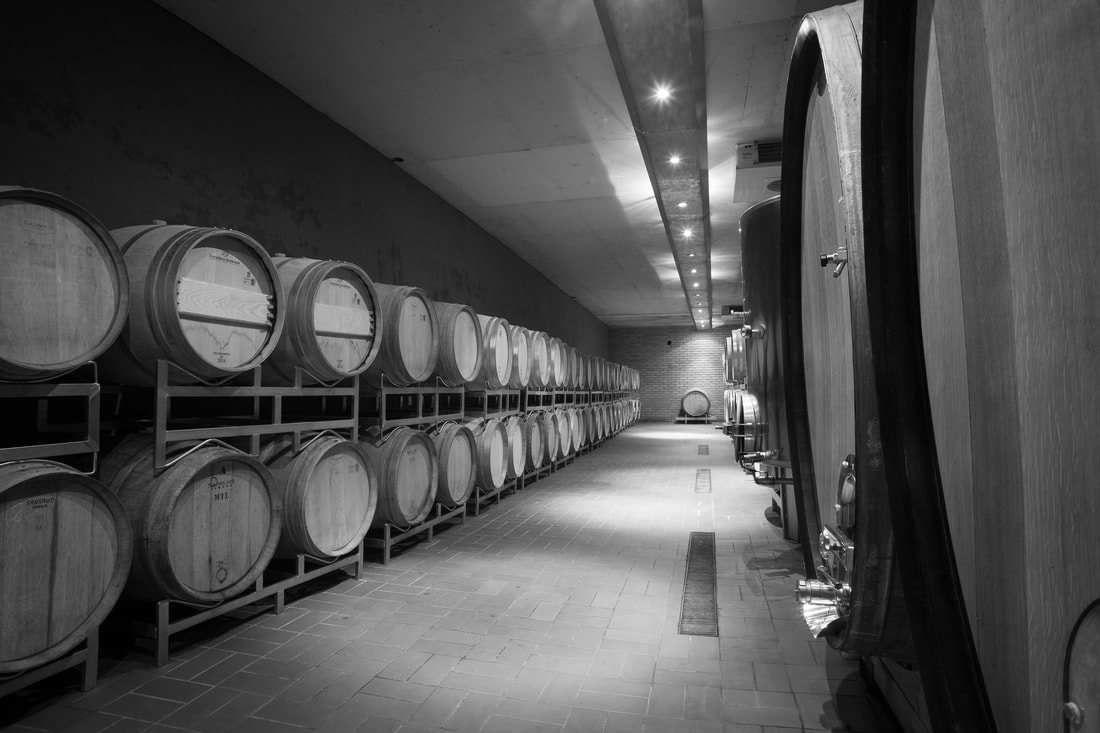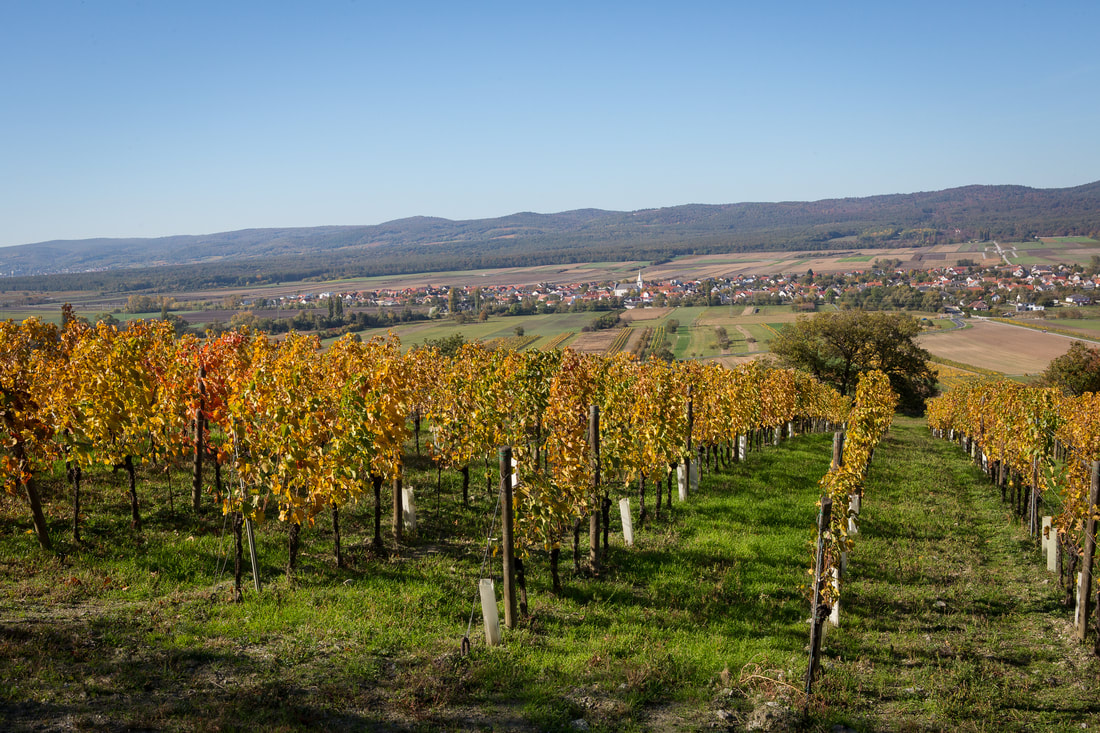Weingut Prieler
Burgenland, Austria
Winemaker: Georg Prieler
The Prieler estate, in Schützen on the western side of the Lake Neusiedl, is a historic old farm, once dedicated to many types of agriculture but now specializing in grape growing. Two generations of the Prieler family now run the estate: Engelbert and Irmgard, who in 1972 focused the estate on quality production of several grape varieties, mainly blaufränkisch and Burgundian varieties. Their son, Georg, now heads the estate and continues working to best express the unique terroir of the Leithagebirge.
Prieler’s 20 hectares are currently cultivated in vineyards between the Leithagebirge, the last outpost of the eastern Alps that protect the vines from the western winds, and the Lake Neusiedl, which tempers the hot climate of the Pannonian plain. Basking in 2000 hours of sunshine annually, North Burgenland is the sunniest region in all of central Europe, with far below average rain fall. Soils vary dramatically in this area around the Schützen Stein. Seeberg and Sinner vineyards contain fossil bearing limestone and are best suited, to Prieler’s outstanding Chardonnay and Pinot Blanc. The iron-rich, brown loam of the Johanneshöhe on the slopes of the Leithaberg produces delicious blaufränkisch, while the Goldberg vineyard, filled with ‘glimmerschiefer’, or mica-schist, flecked with gold, produces one of the most important, world-class wines in all of Austria.
Prieler’s focus on blaufränkisch as well as Burgundian varieties such as chardonnay, pinot blanc, and pinot noir, which have a long history of cultivation in this part of Burgenland. The area around Vienna was cultivated by Cistercian and Franciscan monks, who founded monasteries along the Danube and brought these varieties from France and Germany. Silvia Prieler, with a PhD in biochemistry, brings international experience to the cellar including an interim at Domaine Dujac in Burgundy. In the vineyards, the Prielers prune rigorously, plant cover crops and pay meticulous attention to canopy management as their region receives so much sunlight. They make multiple, careful selections during harvest in order to control alcohol while still achieving physiological ripeness.
The grapes are carefully crushed and fermented at closely controlled temperatures in steel tanks or wooden casks. The character of the variety and the vineyard determines where the wine will mature. For example, the Seeberg pinot blanc will remain in stainless steel to maximize freshness and clarity, the blaufränkisch from Johanneshöhe will be raised in large oak casks, and top crus like Goldberg will mature in barrique. Prieler’s meticulous work in the vineyard and in the cellar has earned them awards from Falstaff Magazine (2009 “Vintner of the Year”), Vinaria Magazine (“Best wines of Austria” 2012/2013) and was among Jancis Robinson’s top picks for Austrian red wines. Peter Moser, editor-in-chief of Falstaff wrote, “We were extremely impressed by the Prieler family’s high standards in all wine categories and by their sensitive approach to the specific properties of the respective types of vine and the selection of just the right terroir.”
Wines Imported to Australia
2020 'Kalkteressen' Gemischter Satz - COMING SOON
2019 'Ried Seeberg' - COMING SOON
"Pinot BlancPinot Blanc is a demanding variety. Like the other Burgundian variety, it is a child of the soil in which it grows. The soil of Seeberg is interspersed with lime and often warmed by the sun. It absorbs and stores the infrequent precipitation optimally, thus promoting available nutrition for the vines.
Harvested fully ripe and healthy, I allow the must to macerate for three days on the skins to gently extract its hidden fruit components. The resulting aroma spectrum opens quietly, but persistently with ripe pear, blossom and meadow notes that are bedded in a juicy, balanced texture." Georg Prieler
2020 'Vom stien' Rosé - COMING SOON
2018 'Johanneshöhe' Blaufränkish - COMING SOON
"The prologue. The grapes for this wine stem from nine different vineyards, nearly all of which have iron and fossil-rich cambisol soil. My intention with the Johanneshöhe interpretation is to express a particular lightness in Blaufränkisch. Elegance, drinkability and fruit are the focus while tannin, power and spice remain satisfied in supporting roles. Please don’t understand this wrong. Depth, balance and intensity still have highest priority in Johanneshöhe; they are simply bedded on a more airy foundation." Georg Prieler
2016 'Leithaberg' Blaufränkish
"My red Leithaberg wine comes from the Ried Pratsche on the hill that rises directly behind Oggau from where you have a view over the reed belt to Lake Neusiedl. You also feel the lake here as it is carried by warm winds to rest on leaves and grapes. The mild climate contrasts with the cool limestone and together, they offer exactly the right conditions for puristic, clear, precise Blaufränkisch. Nothing happens in the cellar that wasn’t done 70 years ago. The aromas from then and now are probably not dissimilar; delicate red fruit, black pepper, a couple of ripe plums and a salty background spread invitingly over the palate." Georg Prieler
2015 'Goldberg' Blaufränkish
"Many things are different in Goldberg. The vineyard faces away from the lake and it is not based on limestone, but rather on schist. Refreshing winds circulate though vine rows that my father planted in his soils in 1972, the year he took over the winery. He was also the one that first explored the intrinsic quality of Goldberg. He observed, analysed and made subsequently decisions that made it one of the great wines of Burgenland.
Finesse and power unite in Blaufränkisch from Goldberg. Its tannin structure is compact and the aromas first suggest warmth and autumn leaves before revealing red fruit notes. You taste wild cherry in warm vintages, while in cooler years sour cherry and fresh earthiness set the tone." Georg Prieler
Prieler’s 20 hectares are currently cultivated in vineyards between the Leithagebirge, the last outpost of the eastern Alps that protect the vines from the western winds, and the Lake Neusiedl, which tempers the hot climate of the Pannonian plain. Basking in 2000 hours of sunshine annually, North Burgenland is the sunniest region in all of central Europe, with far below average rain fall. Soils vary dramatically in this area around the Schützen Stein. Seeberg and Sinner vineyards contain fossil bearing limestone and are best suited, to Prieler’s outstanding Chardonnay and Pinot Blanc. The iron-rich, brown loam of the Johanneshöhe on the slopes of the Leithaberg produces delicious blaufränkisch, while the Goldberg vineyard, filled with ‘glimmerschiefer’, or mica-schist, flecked with gold, produces one of the most important, world-class wines in all of Austria.
Prieler’s focus on blaufränkisch as well as Burgundian varieties such as chardonnay, pinot blanc, and pinot noir, which have a long history of cultivation in this part of Burgenland. The area around Vienna was cultivated by Cistercian and Franciscan monks, who founded monasteries along the Danube and brought these varieties from France and Germany. Silvia Prieler, with a PhD in biochemistry, brings international experience to the cellar including an interim at Domaine Dujac in Burgundy. In the vineyards, the Prielers prune rigorously, plant cover crops and pay meticulous attention to canopy management as their region receives so much sunlight. They make multiple, careful selections during harvest in order to control alcohol while still achieving physiological ripeness.
The grapes are carefully crushed and fermented at closely controlled temperatures in steel tanks or wooden casks. The character of the variety and the vineyard determines where the wine will mature. For example, the Seeberg pinot blanc will remain in stainless steel to maximize freshness and clarity, the blaufränkisch from Johanneshöhe will be raised in large oak casks, and top crus like Goldberg will mature in barrique. Prieler’s meticulous work in the vineyard and in the cellar has earned them awards from Falstaff Magazine (2009 “Vintner of the Year”), Vinaria Magazine (“Best wines of Austria” 2012/2013) and was among Jancis Robinson’s top picks for Austrian red wines. Peter Moser, editor-in-chief of Falstaff wrote, “We were extremely impressed by the Prieler family’s high standards in all wine categories and by their sensitive approach to the specific properties of the respective types of vine and the selection of just the right terroir.”
Wines Imported to Australia
2020 'Kalkteressen' Gemischter Satz - COMING SOON
2019 'Ried Seeberg' - COMING SOON
"Pinot BlancPinot Blanc is a demanding variety. Like the other Burgundian variety, it is a child of the soil in which it grows. The soil of Seeberg is interspersed with lime and often warmed by the sun. It absorbs and stores the infrequent precipitation optimally, thus promoting available nutrition for the vines.
Harvested fully ripe and healthy, I allow the must to macerate for three days on the skins to gently extract its hidden fruit components. The resulting aroma spectrum opens quietly, but persistently with ripe pear, blossom and meadow notes that are bedded in a juicy, balanced texture." Georg Prieler
2020 'Vom stien' Rosé - COMING SOON
2018 'Johanneshöhe' Blaufränkish - COMING SOON
"The prologue. The grapes for this wine stem from nine different vineyards, nearly all of which have iron and fossil-rich cambisol soil. My intention with the Johanneshöhe interpretation is to express a particular lightness in Blaufränkisch. Elegance, drinkability and fruit are the focus while tannin, power and spice remain satisfied in supporting roles. Please don’t understand this wrong. Depth, balance and intensity still have highest priority in Johanneshöhe; they are simply bedded on a more airy foundation." Georg Prieler
2016 'Leithaberg' Blaufränkish
"My red Leithaberg wine comes from the Ried Pratsche on the hill that rises directly behind Oggau from where you have a view over the reed belt to Lake Neusiedl. You also feel the lake here as it is carried by warm winds to rest on leaves and grapes. The mild climate contrasts with the cool limestone and together, they offer exactly the right conditions for puristic, clear, precise Blaufränkisch. Nothing happens in the cellar that wasn’t done 70 years ago. The aromas from then and now are probably not dissimilar; delicate red fruit, black pepper, a couple of ripe plums and a salty background spread invitingly over the palate." Georg Prieler
2015 'Goldberg' Blaufränkish
"Many things are different in Goldberg. The vineyard faces away from the lake and it is not based on limestone, but rather on schist. Refreshing winds circulate though vine rows that my father planted in his soils in 1972, the year he took over the winery. He was also the one that first explored the intrinsic quality of Goldberg. He observed, analysed and made subsequently decisions that made it one of the great wines of Burgenland.
Finesse and power unite in Blaufränkisch from Goldberg. Its tannin structure is compact and the aromas first suggest warmth and autumn leaves before revealing red fruit notes. You taste wild cherry in warm vintages, while in cooler years sour cherry and fresh earthiness set the tone." Georg Prieler




